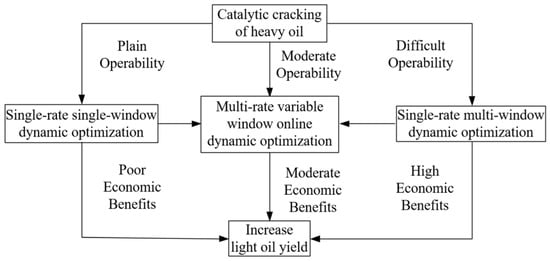Online Dynamic Optimization of Multi-Rate Processes with the Case of a Fluid Catalytic Cracking Unit
Abstract
:1. Introduction
2. Expansion of Heavy Oil FCCU Model and Multi-Rate, Variable-Window Online Dynamic Optimization Analysis
3. Necessity Analysis and Mathematical Description of Multi-Rate, Variable-Window Online Dynamic Optimization
3.1. Single-Rate Optimization and Multi-Rate Optimization
3.2. Mathematical Description of Single-Rate, Single-Window Optimization
3.3. Mathematical Description of Single-Rate Multi-Window Optimization
3.4. Multi-Rate, Variable-Window Online Dynamic Optimization Research and Process Description
4. Multi-Rate, Variable-Window Online Dynamic Optimization Solution Process
5. Experimental Study on Catalytic Cracking
5.1. Operating Characteristics of FCCU under Nominal Conditions
5.2. Case Analysis of Catalytic Cracking
6. Conclusions
Author Contributions
Funding
Data Availability Statement
Acknowledgments
Conflicts of Interest
Nomenclature
| Symbols | |
| A | area, m2 |
| C | coke content of catalysts, % |
| Cp | heat capacity, kJ/(kg·°C) |
| dp | average particle size of catalyst, m |
| D | diffusion coefficient, m2/s |
| DT | combustor diameter, m |
| E | activation energy, kJ/mol |
| F | mass flow rate, t/h |
| G | catalyst circulation rate, kg/s |
| h | film heat transfer coefficient, W/(m2·°C) |
| H | hydrogen content of catalysts, % |
| k | rate coefficient of a reaction or mass transfer rate coefficient |
| K | heat transfer coefficient |
| m | integer constant |
| M | mass flow rate, kg/s |
| N | constant coefficient |
| Nu | Nusselt number |
| O | cross-sectional area, m2 |
| P | pressure, Pa |
| Pe | Peclect number |
| Qs | total heat release, kJ/s |
| R | ideal gas constant, kJ/(mol·°C) |
| Rg | gas molar flux, mol/(m2·s) |
| Rtotal | catalyst mass flux, kg/(m2·s) |
| S | heat transfer area, m2 |
| T | temperature, °C |
| uf | linear velocity, m/s |
| V | gas flow rate, m3/s |
| W | inventory, t |
| xpro | amount of added CO combustion promoters, % |
| y | product yield or gas content, % |
| ZT | combustor length, m |
| Greek Letters | |
| β | carbon residue is converted to additional carbon, kg/kg |
| ΔH | reaction enthalpy, kJ/kg or kJ/mol |
| ΔT1 | temperature difference between Trg1 and saturated steam |
| ΔT2 | temperature difference between Trg2 and saturated steam |
| ΔT | log mean temperature difference, °C |
| ΔTf | temperature rise in the dilute phase, °C |
| ΔTw | coke-burning tank heat dissipation temperature difference, °C |
| γ | latent heat of vaporization of saturated water, kJ/kg |
| ε | Porosity |
| η | hydrogen−carbon molar ratio, H/C |
| η0 | heat extraction ratio, % |
| λg | axial thermal conductivity of gas, W/(m·K) |
| ρ | density, kg/m3 or mol/m3 |
| Subscripts and Superscripts | |
| C | coke |
| d | membrane |
| fresh | feedstock oil |
| g | gas phase |
| h | heat |
| hco | recycle oil |
| H | hydrogen |
| pro | combustion promoters |
| rg1 | combustor |
| rg2 | dense bed |
| rg3 | catalyst cooler |
| riser | reaction temperature |
| s | solid phase |
| sc | spent catalyst |
| slurry | recycle slurry |
| st | stripper |
| w | water or wall |
| ′0 | average after mixing |
| ′rg2 | external catalyst cooler output temperature |
| 1 | water vapor or inside |
| 2 | fluidizing air or outside |
Appendix A. Some Important Operating Parameters of FCCU
| Parameters | Value | Units |
| dense phase length, Lrg2 | 16 | m |
| external catalyst cooler height, Hs | 7.5 | m |
| reactor cross-sectional area, Ora | 0.636 | m2 |
| riser length, xt | 32 | m |
| wear-resistant heat-resistant layer density, ρi | 1845 | kg/m3 |
| cross-sectional area of coke-burning tank, Org1 | 19.63 | m2 |
| height of coke-burning tank, zt | 9.81 | m |
| coke-burning tank diameter, Dt | 5 | m |
| cross-sectional area of dense bed, Org2 | 9.23 | m2 |
| equivalent heat dissipation area of dense bed, Arg2 | 240.745 | m2 |
| total length of heat pipe, LT | 14 | m |
| catalyst particle density, ρs | 823.5 | kg/m3 |
| cross-sectional area of dilute phase, Od | 38.46 | m2 |
| part of carbon residue converted to additional carbon in feedstock oil, β | 0.6 | kg/kg |
| hydrogen−carbon molar ratio, η | 8/92 | kg/kg |
Appendix B. Research on Accounting Process
References
- Biegler, L.T. An overview of simultaneous strategies for dynamic optimization. Chem. Eng. Process. Process Intensif. 2007, 46, 1043–1053. [Google Scholar] [CrossRef]
- Biegler, L.T.; Cervantes, A.M.; Wachter, A. Advances in simultaneous strategies for dynamic process optimization. Chem. Eng. Sci. 2002, 57, 575–593. [Google Scholar] [CrossRef]
- Zhang, Y.D.; Mo, Y.B. Dynamic Optimization of Chemical Processes Based on Modified Sailfish Optimizer Combined with an Equal Division Method. Processes 2021, 9, 1806. [Google Scholar] [CrossRef]
- Schlegel, M.; Stockmann, K.; Binder, T.; Marquardt, W. Dynamic optimization using adaptive control vector parameterization. Comput. Chem. Eng. 2005, 29, 1731–1751. [Google Scholar] [CrossRef]
- Kameswaran, S.; Biegler, L.T. Simultaneous dynamic optimization strategies: Recent advances and challenges. Comput. Chem. Eng. 2006, 30, 1560–1575. [Google Scholar] [CrossRef]
- Asgari, S.A.; Pishvaie, M.R. Dynamic optimization in chemical processes using region reduction strategy and control vector parameterization with an ant colony optimization algorithm. Chem. Eng. Technol. 2008, 31, 507–512. [Google Scholar] [CrossRef]
- Chen, X.; Du, W.L.; Tianfield, H.; Qi, R.B.; He, W.L.; Qian, F. Dynamic optimization of industrial processes with nonuniform discretization-based control vector parameterization. IEEE Trans. Autom. Sci. Eng. 2014, 11, 1289–1299. [Google Scholar] [CrossRef]
- Zhang, Y.H.; Chen, G.X.; Yan, G.S.; Li, B.; Lu, J.; Jiang, W. Multi-Objective Optimization of Kinetic Characteristics for the LBPRM-EHSPCS System. Processes 2023, 11, 2623. [Google Scholar] [CrossRef]
- Hartwich, A.; Marquardt, W. Dynamic optimization of the load change of a large-scale chemical plant by adaptive single shooting. Comput. Chem. Eng. 2010, 34, 1873–1889. [Google Scholar] [CrossRef]
- De Prada, C.; Mazaeda, R.; Podar, S. Optimal operation of a combined continuous–batch process. Comput. Aid. Chem. Eng. 2018, 44, 673–678. [Google Scholar]
- Ding, F.; Chen, T.W. Modeling and identification of multirate systems. Act. Auto. Sin. 2005, 31, 105–122. [Google Scholar]
- Arandes, J.M.; Torre, I.; Azkoiti, M.J.; Erena, J.; Bilbao, J. Effect of atmospheric residue incorporation in the fluidized catalytic cracking (FCC) feed on product stream yields and composition. Energy Fuels 2008, 22, 2149–2156. [Google Scholar] [CrossRef]
- Chen, L.H.; Cheng, M.Z.; Cai, Y.; Guo, L.; Gao, D. Multi−Objective Collaborative Optimization Design of Key Structural Parameters for Coal Breaking and Punching Nozzle. Processes 2022, 10, 1036. [Google Scholar] [CrossRef]
- Harding, R.H.; Peters, A.W.; Nee, J.R.D. New developments in FCC catalyst technology. Appl. Catal. A 2001, 221, 389–396. [Google Scholar] [CrossRef]
- Spretz, R.; Sedran, U. Operation of FCC with mixtures of regenerated and deactivated catalyst. Appl. Catal. A 2001, 215, 199–209. [Google Scholar] [CrossRef]
- Devard, A.; Puente, G.; Passamonti, F.; Sedran, U. Processing of resid–VGO mixtures in FCC: Laboratory approach. Appl. Catal. A 2009, 353, 223–227. [Google Scholar] [CrossRef]
- Srinivasan, B.; Palanki, S.; Bonvin, D. Dynamic optimization of batch processes: I. Characterization of the nominal solution. Comput. Chem. Eng. 2003, 27, 1–26. [Google Scholar] [CrossRef]
- Xu, Y.H.; Zhang, J.S.; Long, J.; He, M.Y.; Xu, H.; Hao, X.R. Development and commercial application of FCC process for maximizing iso-paraffins (MIP) in cracked naphtha. Eng. Sci. 2003, 5, 55–58. [Google Scholar]
- Ancheyta, J.J.; Lopez, F.I.; Aguilar, E.R. Correlations for predicting the effect of feedstock properties on catalytic cracking kinetic parameters. Ind. Eng. Chem. Res. 1998, 37, 4637–4640. [Google Scholar] [CrossRef]
- Ancheyta, J.J.; Lopez, F.I.; Aguilar, E.R. 5-Lump kinetic model for gas oil catalytic cracking. Appl. Catal. A 1999, 177, 227–235. [Google Scholar] [CrossRef]
- Wang, H.; Sheng, B.; Lu, Q.; Yin, X.; Zhao, F.; Lu, X.; Luo, R.; Fu, G. A novel multi-objective optimization algorithm for the integrated scheduling of flexible job shops considering preventive maintenance activities and transportation processes. Soft Comput. 2021, 25, 2863–2889. [Google Scholar] [CrossRef]
- Ancheyta, J.J.; Lopez, F.I.; Aguilar, E.R. A strategy for kinetic parameter estimation in the fluid catalytic cracking process. Ind. Eng. Chem. Res. 1997, 36, 5170–5174. [Google Scholar] [CrossRef]
- Otterstedt, J.E.; Gevert, S.B.; Jas, S.G.; Menon, P.G. Fluid catalytic cracking of heavy (residual) oil fractions: A review. Appl. Catal. 1986, 22, 159–179. [Google Scholar] [CrossRef]
- Ahmadi, E.; Zandieh, M.; Farrokh, M.; Emami, S.M. A multi objective optimization approach for flexible job shop scheduling problem under random machine breakdown by evolutionary algorithms. Comput. Oper. Res. 2016, 73, 56–66. [Google Scholar] [CrossRef]
- Chu, Y.; You, F. Integrated Scheduling and Dynamic Optimization of Complex Batch Processes with General Network Structure Using a Generalized Benders Decomposition Approach. Ind. Eng. Chem. Res. 2013, 52, 7867–7885. [Google Scholar] [CrossRef]
- Nie, Y.; Biegler, L.T.; Villa, C.M.; Wassick, J.M. Discrete time formulation for the integration of scheduling and dynamic optimization. Ind. Eng. Chem. Res. 2015, 54, 4303–4315. [Google Scholar] [CrossRef]
- Wu, Y.C.; Sun, G.; Tao, J. An Improved Multi-Objective Particle Swarm Optimization Method for Rotor Airfoil Design. Aerospace 2023, 10, 820. [Google Scholar] [CrossRef]
- Li, R.; Chen, Y.L.; Song, J.Z.; Li, M.; Yu, Y. Multi-Objective Optimization Method of Industrial Workshop Layout from the Perspective of Low Carbon. Sustainability 2023, 15, 12275. [Google Scholar] [CrossRef]
- Zhang, X.; Zhang, G.Y.; Zhang, D.; Zhang, L.; Qian, F. Dynamic Multi-Objective Optimization in Brazier-Type Gasification and Carbonization Furnace. Materials 2023, 16, 1164. [Google Scholar] [CrossRef]
- Hu, Q.; Zhai, X.Y.; Li, Z.F. Multi-Objective Optimization of Deep-Sea Mining Pump Based on CFD, GABP Neural Network and NSGA-III Algorithm. J. Mar. Sci. Eng. 2022, 10, 1063. [Google Scholar] [CrossRef]
- Hu, H.G.; Xu, L.H.; Wei, R.H.; Zhu, B. Multi-Objective Control Optimization for Greenhouse Environment Using Evolutionary Algorithms. Sensors 2011, 11, 5792–5807. [Google Scholar] [CrossRef] [PubMed]
- Ke, W.L.; Sha, J.H.; Yan, J.J.; Zhang, G.; Wu, R. A Multi-Objective Input–Output Linear Model for Water Supply, Economic Growth and Environmental Planning in Resource-Based Cities. Sustainability 2016, 8, 160. [Google Scholar] [CrossRef]
- Quan, Z.; Wang, Y.; Ji, Z. Multi-objective optimization scheduling for manufacturing process based on virtual workflow models. Appl. Soft Comput. 2022, 122, 108786. [Google Scholar] [CrossRef]
- Arbel, A.; Huang, Z.; Rinard, I.H.; Shinnar, R.; Sapre, A.V. Dynamic and Control of Fluidized Catalytic Crackers. 1. Modeling of the Current Generation of FCC’s. Ind. Eng. Chem. Res. 1995, 34, 1228–1243. [Google Scholar] [CrossRef]
- Lin, J.J.; Xu, F.; Luo, X. Dynamic Optimization of Continuous-Batch Processes: A Case Study of an FCCU with CO Promoter. Ind. Eng. Chem. Res. 2019, 58, 23187–23200. [Google Scholar] [CrossRef]
- Wang, M.C.; Li, Y.J.; Yuan, J.P.; Osman, F.K. Matching Optimization of a Mixed Flow Pump Impeller and Diffuser Based on the Inverse Design Method. Processes 2021, 9, 260. [Google Scholar] [CrossRef]
- Nie, Y.; Biegler, L.T.; Wassick, J.M. Integrated scheduling and dynamic optimization of batch processes using state equipment networks. AICHE J. 2012, 58, 3416–3432. [Google Scholar] [CrossRef]
- Weng, J.Z.; Shao, Z.J.; Chen, X.; Gu, X.P.; Yao, Z.; Feng, L.F.; Biegler, L.T. A novel strategy for dynamic optimization of grade transition processes based on molecular weight distribution. AIChE J. 2014, 60, 2498–2512. [Google Scholar] [CrossRef]
- Prata, A.; Oldenburg, J.; Kroll, A.; Marquardt, W. Integrated scheduling and dynamic optimization of grade transitions for a continuous polymerization reactor. Comput. Chem. Eng. 2008, 32, 463–476. [Google Scholar] [CrossRef]
- Morison, K.R.; Sargent, R.W.H. Optimization of multistage processes described by differential-algebraic equations. In Numerical Analysis; Springer: Berlin/Heidelberg, Germany, 1986; pp. 86–102. [Google Scholar]
- Liu, R.; Li, J.; Liu, J.; Jiao, L. A survey on dynamic multi-objective optimization. Chin. J. Comput. 2020, 43, 1246–1278. [Google Scholar]
- Binder, T.; Cruse, A.; Villar, C.A.C.; Marquardt, W. Dynamic optimization using a wavelet based adaptive control vector parameterization strategy. Comput. Chem. Eng. 2000, 24, 1201–1207. [Google Scholar] [CrossRef]
- Wongrat, W.; Younes, A.; Elkamel, A.; Douglas, P.L.; Lohi, A. Control vector optimization and genetic algorithms for mixed-integer dynamic optimization in the synthesis of rice drying processes. J. Franklin. Inst. 2011, 348, 1318–1338. [Google Scholar] [CrossRef]
- Luo, Z.Y.; Tan, S.X.; Liu, X.T.; Xu, H.; Liu, J. Multi-Objective Workflow Optimization Algorithm Based on a Dynamic Virtual Staged Pruning Strategy. Processes 2023, 11, 1160. [Google Scholar] [CrossRef]
- Zhang, P.P.; Chen, H.M.; Liu, X.G.; Zhang, Z.Y. An iterative multi-objective particle swarm optimization-based control vector parameterization for state constrained chemical and biochemical engineering problems. Biochem. Eng. J. 2015, 103, 138–151. [Google Scholar] [CrossRef]
- Pili, R.; Jørgensen, B.J.; Haglind, F. Multi-objective optimization of organic Rankine cycle systems considering their dynamic performance. Energy 2022, 246, 123345. [Google Scholar] [CrossRef]
- Zhang, J.; Shen, Y.; Gan, M.; Su, Q.; Lyu, F.; Xu, B.; Chen, Y. Multi-objective optimization of surface texture for the slipper/swash plate interface in EHA pumps. Front. Mech. Eng. 2022, 17, 48. [Google Scholar] [CrossRef]
- Zhang, J.F.; Lin, J.; Luo, X.; Xu, F. Modeling analysis for product distribution control and optimization of heavy oil FCCU. CIESC J. 2022, 73, 1232–1245. [Google Scholar]
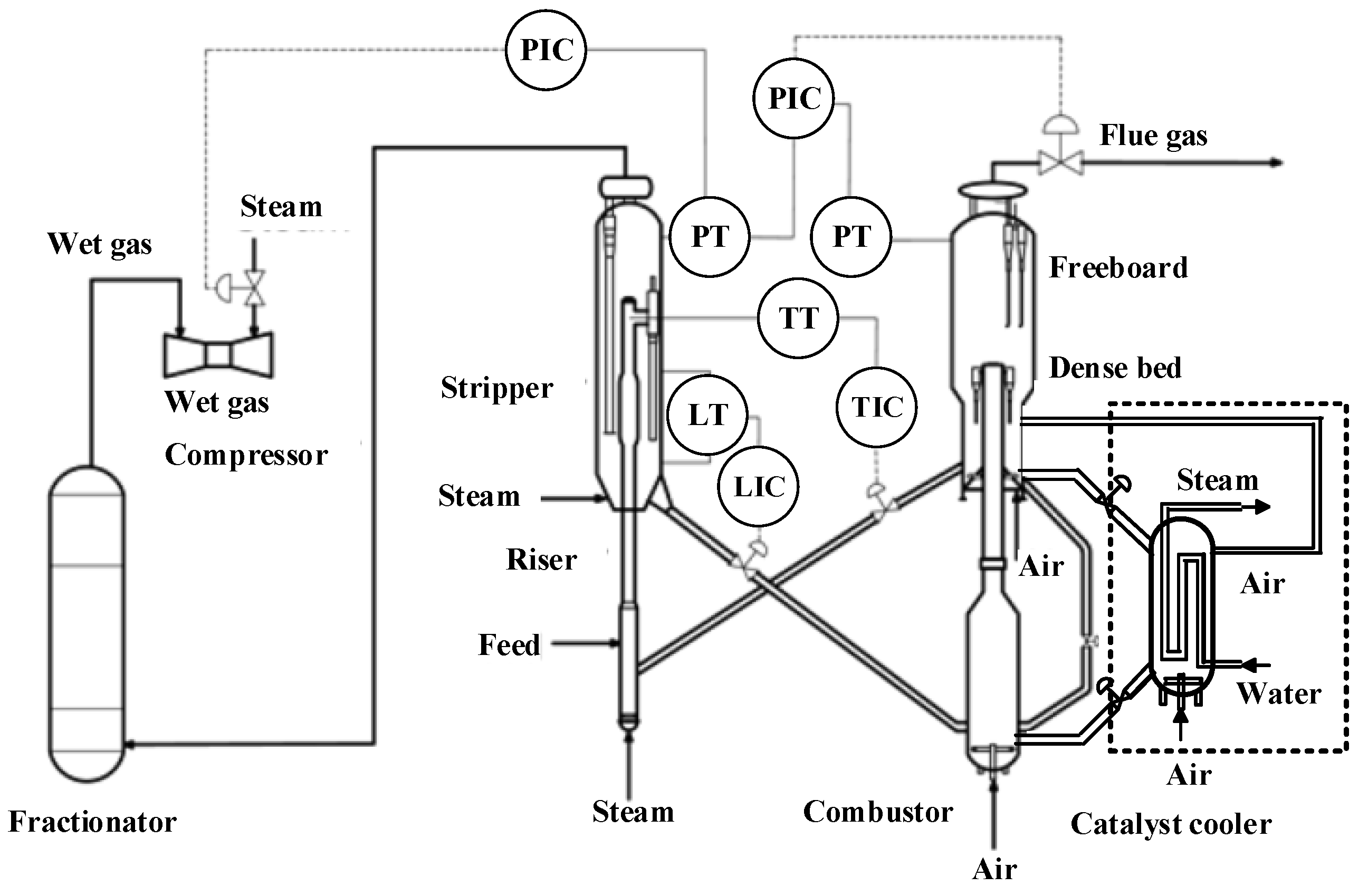


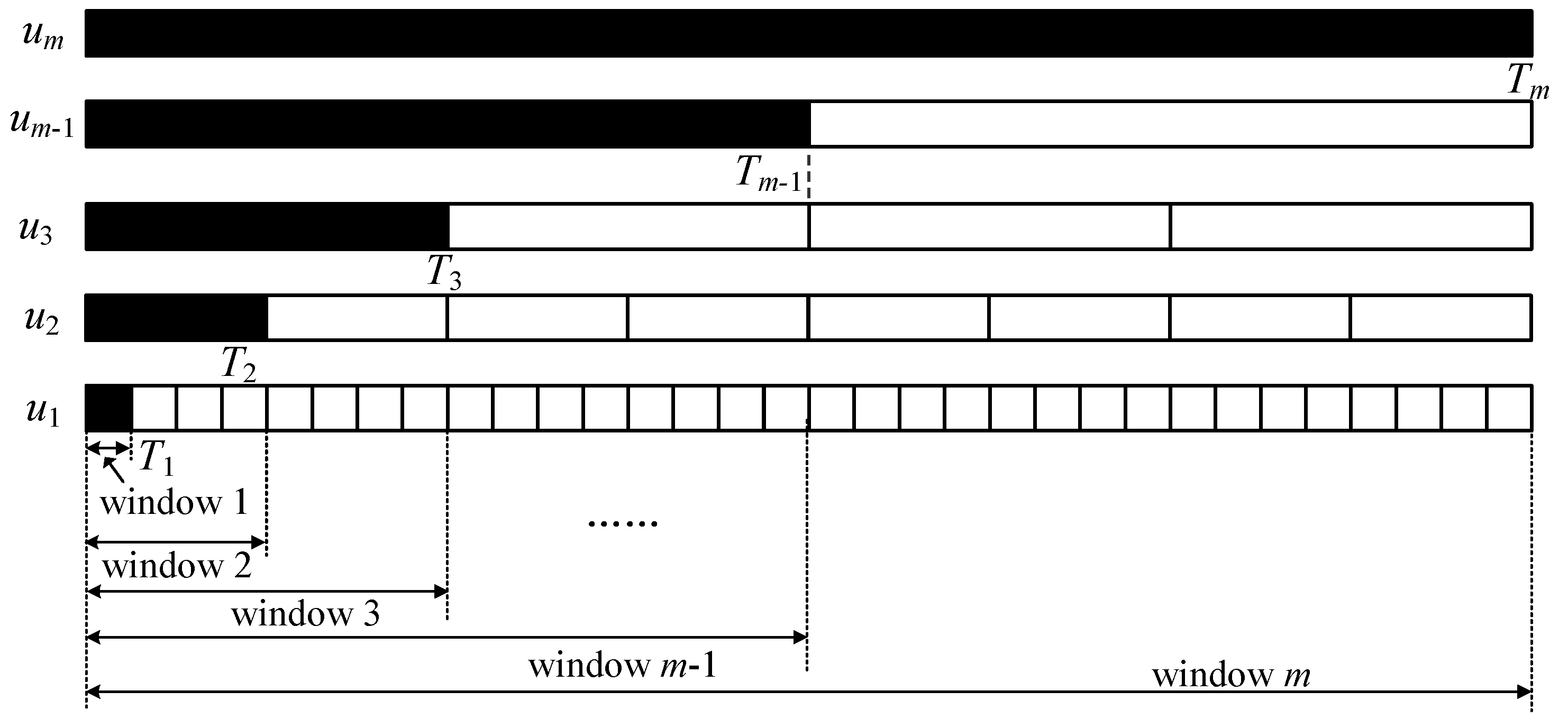
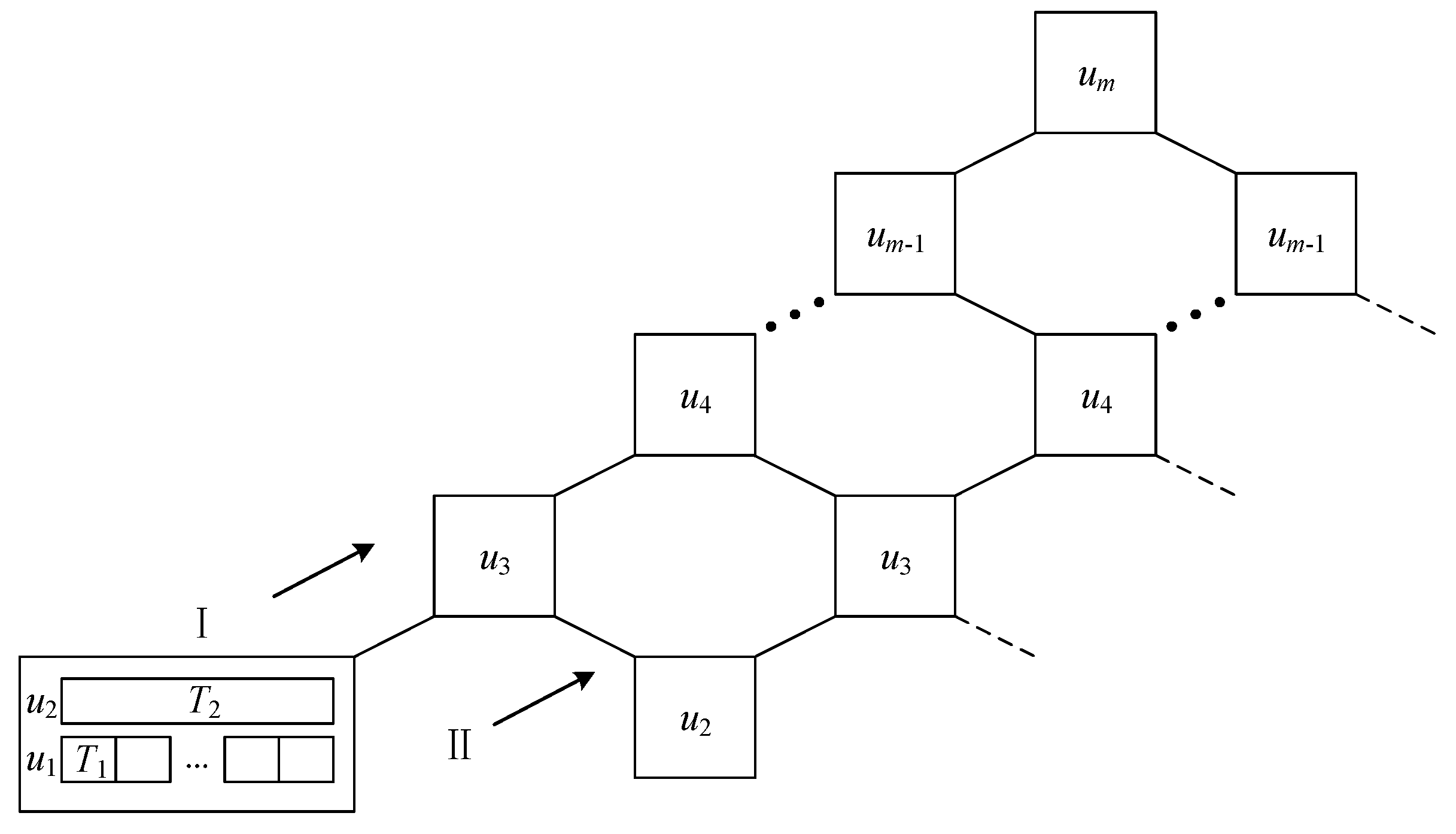
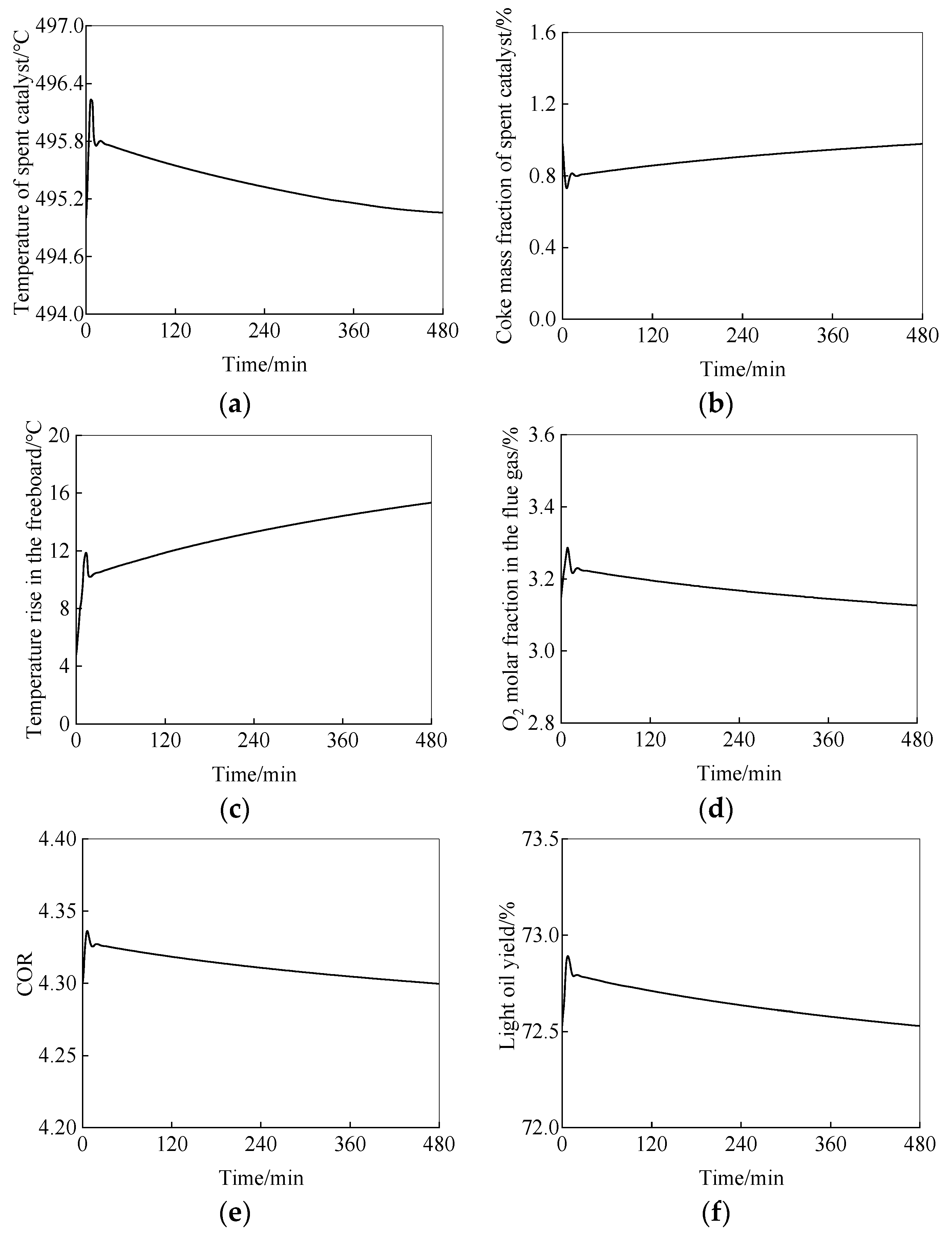
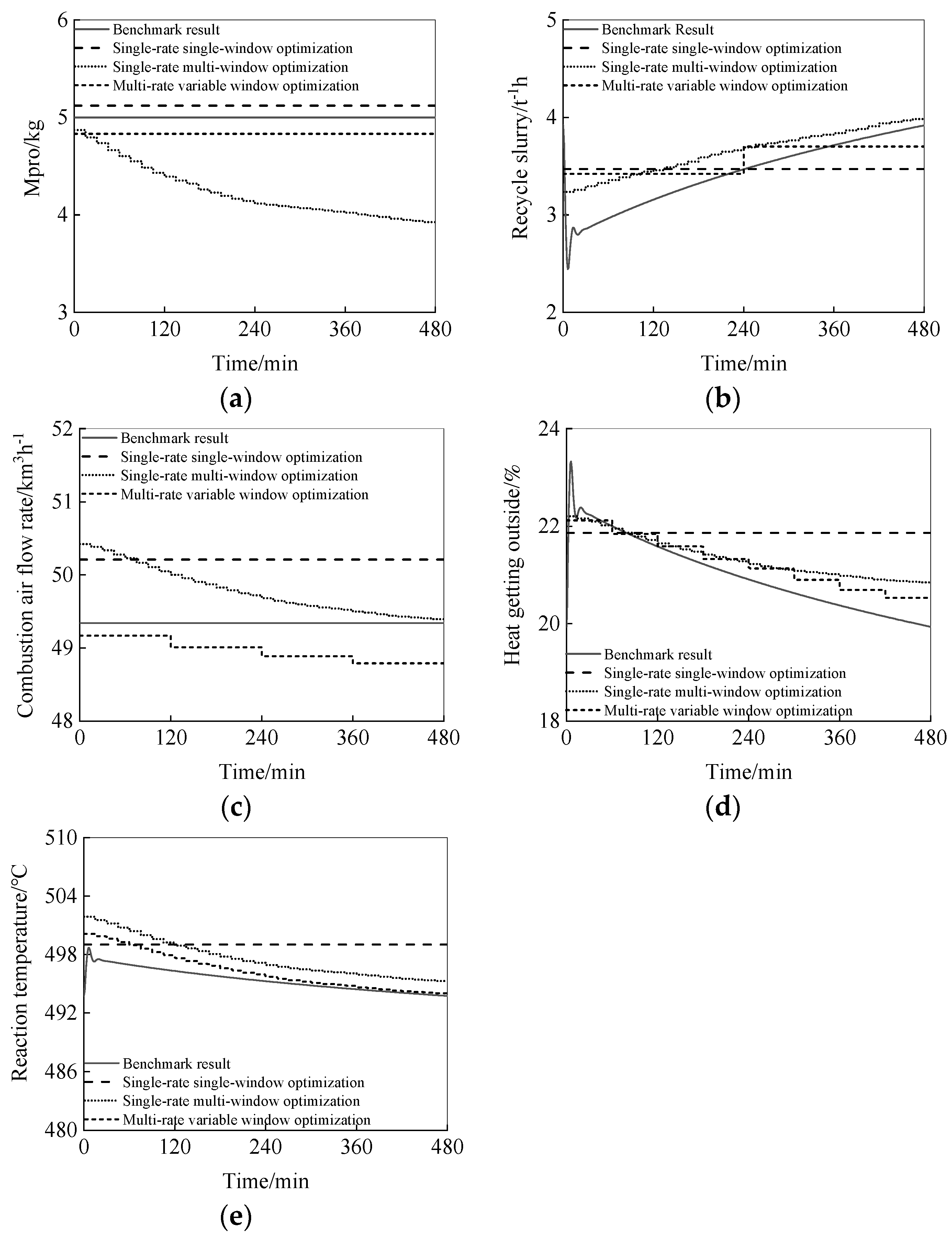
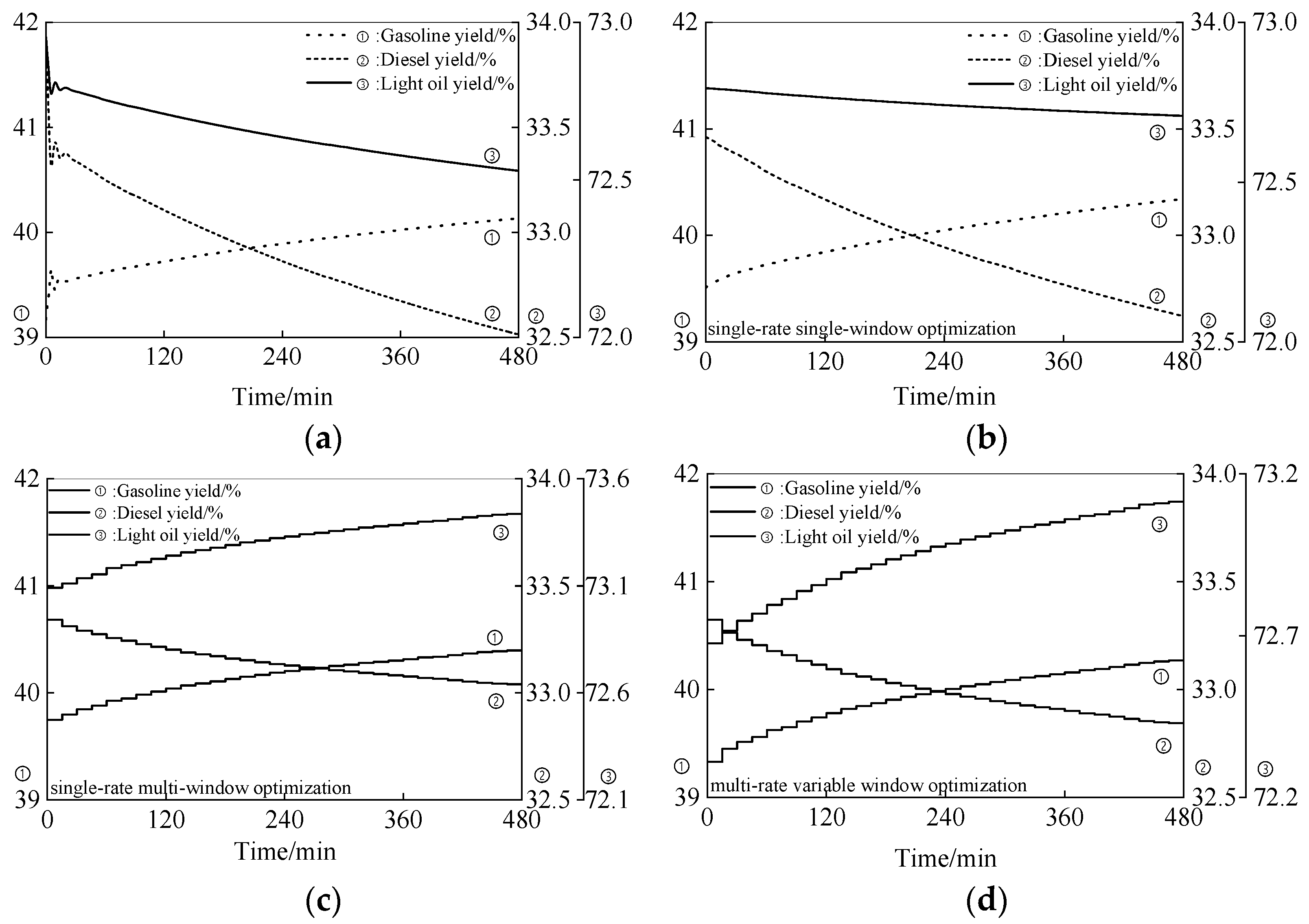

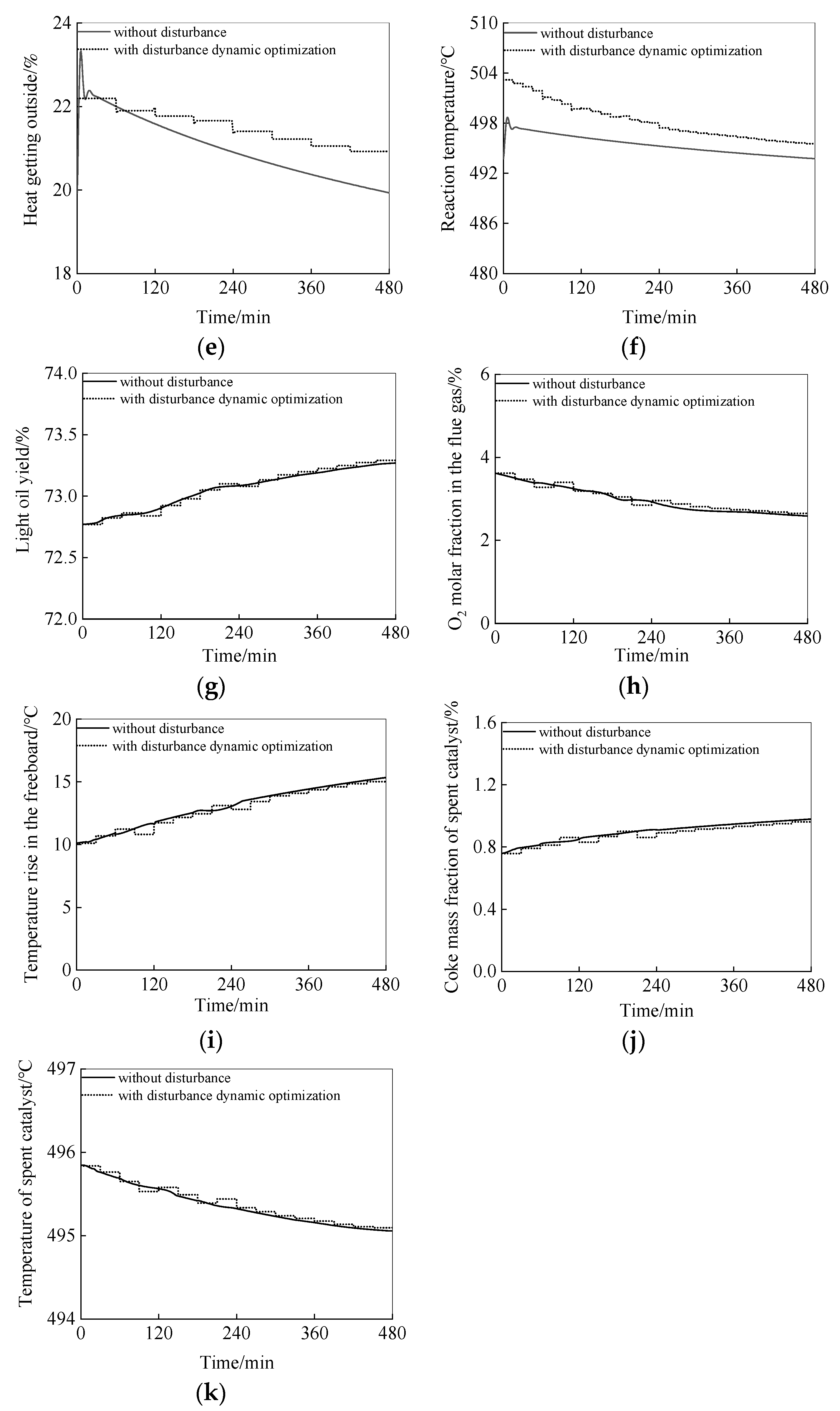
| Time | Optimization Variables | Variables |
|---|---|---|
| [0, T2] | u1 | u2, u3, …, um |
| [T2, T3] | u1, u2 | u3, u4, …, um |
| [T3, T4] | u1, u2, u3 | u4, u5, …, um |
| … | … | … |
| [Tm−1, Tm] | u1, u2, …, um−1 | um |
| Variables | Value | Units |
|---|---|---|
| fresh feed flow rate, Ffresh | 85 | t/h |
| HCO flow rate, Fhco | 12.75 | t/h |
| regenerated catalyst circulation rate, Grg2 | 504.2 | t/h |
| catalyst-to-oil ratio, COR | 4.31 | wt/wt |
| combustion air flow rate, Vrg1 | 49,340 | m3/h |
| fluffing air flow rate, Vrg2 | 6658 | m3/h |
| amount of added CO combustion promoters, Mpro | 5 | kg |
| concentration of CO combustion promoters, xpro | 0.005 | wt% |
| inventories, W (combustor/dense bed/stripper) | 24/5/5 | t |
| reaction temperature, Triser | 495.4 | °C |
| recycle slurry flow rate, Fslurry | 3.35 | t/h |
| heat getting outside ratio, η0 | 21 | % |
| combustor top temperature, Trg1 | 698.6 | °C |
| dense bed temperature, Trg2 | 707.3 | °C |
| coke content of spent catalysts, Csc | 0.97 | wt% |
| coke content of regenerated catalysts, Crg2 | 0.045 | wt% |
| O2 content in flue gas, yO2 | 3.17 | mol% |
| CO content in flue gas, yCO | 0.15 | mol% |
| CO2 content in flue gas, yCO2 | 13.85 | mol% |
| Variables | Lower Bound | Upper Bound |
|---|---|---|
| reaction temperature, Triser (°C) | 490 | 510 |
| dense bed temperature, Trg2 (°C) | 680 | 725 |
| coke content of spent catalysts, Csc (wt%) | 0.5 | 1.2 |
| O2 content in flue gas, yO2 (mol%) | 3 | 4 |
| yield of coke, yc (wt%) | 8 | 10.7 |
| yield of diesel, yd (wt%) | 32 | 34 |
| yield of gasoline, yn (wt%) | 39 | 41 |
| yield of wet gas, yg (wt%) | 10 | 20 |
| temperature rise in the freeboard, ΔTf (°C) | −5 | 20 |
| combustion air flow rate, Vrg1 (km3/h) | 40 | 55 |
| amount of added CO promoters, Mpro (kg) | 2 | 7 |
| recycle slurry flow rate, Fslurry (t/h) | 0 | 7.25 |
| combustor top temperature, Trg1 (°C) | 660 | 695 |
| heat escape ratio, η0 (%) | 0 | 30 |
| light oil yield, y (wt%) | 71 | 75 |
| Variables | Gasoline | Diesel | Slurry | CO Combustion Promoters | Combustion Air | Recycle Slurry Energy Consumption | Heat Escape Energy Consumption | Flue Gas Energy | |
|---|---|---|---|---|---|---|---|---|---|
| benchmark operation | 271.014 | 223.829 | 0 | 5 | 1,449,792 | 58 | 0 | 3.17 × 107 | |
| single-rate, single-window optimization period 8 h | dynamic optimization | 271.053 | 223.913 | 30.59 | 5.121 | 1,445,968 | 25.48 | 206.78 | 1.42 × 107 |
| difference | 0.039 t | 0.084 t | 30.59 t | 0.121 kg | −3824 km3 | 25.48 km3 | 206.78 km3 | −1.75 × 107 kJ | |
| benefits | 43.51$ | 79.77$ | 6162.35$ | 3.75$ | 11.19$ | 5.65$ | −45.88$ | −92.84$ | |
| total benefits | 6167.5$ | ||||||||
| single-rate, multi-window optimization period 15 min | dynamic optimization | 271.956 | 224.911 | 26.489 | 4.245 | 1,438,065 | 29.83 | 216.421 | 1.64 × 107 |
| difference | 0.942 t | 1.082 t | 26.489 t | −0.755 kg | −11,727 km3 | 29.83 km3 | 216.421 km3 | −1.53 × 107 kJ | |
| benefits | 1050.62$ | 1026.24$ | 5336.38$ | 23.41$ | 34.32$ | 6.62$ | −48.02$ | −81.17$ | |
| total benefits | 7348.4$ | ||||||||
| multi-rate, variable-window online dynamic optimization | dynamic optimization | 271.227 | 224.282 | 29.826 | 4.832 | 1,443,072 | 26.27 | 190.95 | 1.46 × 107 |
| difference | 0.213 t | 0.453 t | 29.826 t | −0.168 kg | −6720 km3 | 26.27 km3 | 190.95 km3 | −1.71 × 107 kJ | |
| benefits | 273.56$ | 429.65$ | 6008.65$ | 5.21$ | 19.67$ | 5.83$ | −42.37$ | −90.72$ | |
| total benefits | 6609.48$ | ||||||||
| multi-rate, variable-window online dynamic optimization (with disturbance) | dynamic optimization | 272.035 | 224.935 | 26.354 | 4.332 | 1,443,923 | 30.54 | 214.32 | 1.73 × 107 |
| difference | 1.021 t | 1.106 t | 26.354 t | −0.668 kg | −5869 km3 | 30.54 km3 | 214.32 km3 | −1.44 × 107 kJ | |
| benefits | 1311.29$ | 1048.99$ | 5309.19$ | 20.72$ | 17.18$ | 6.77$ | −47.56$ | −76.39$ | |
| total benefits | 7590.19$ | ||||||||
Disclaimer/Publisher’s Note: The statements, opinions and data contained in all publications are solely those of the individual author(s) and contributor(s) and not of MDPI and/or the editor(s). MDPI and/or the editor(s) disclaim responsibility for any injury to people or property resulting from any ideas, methods, instructions or products referred to in the content. |
© 2023 by the authors. Licensee MDPI, Basel, Switzerland. This article is an open access article distributed under the terms and conditions of the Creative Commons Attribution (CC BY) license (https://creativecommons.org/licenses/by/4.0/).
Share and Cite
Zhang, J.; Lin, J.; Xu, F.; Luo, X. Online Dynamic Optimization of Multi-Rate Processes with the Case of a Fluid Catalytic Cracking Unit. Processes 2023, 11, 3088. https://doi.org/10.3390/pr11113088
Zhang J, Lin J, Xu F, Luo X. Online Dynamic Optimization of Multi-Rate Processes with the Case of a Fluid Catalytic Cracking Unit. Processes. 2023; 11(11):3088. https://doi.org/10.3390/pr11113088
Chicago/Turabian StyleZhang, Jianfei, Jiajiang Lin, Feng Xu, and Xionglin Luo. 2023. "Online Dynamic Optimization of Multi-Rate Processes with the Case of a Fluid Catalytic Cracking Unit" Processes 11, no. 11: 3088. https://doi.org/10.3390/pr11113088




